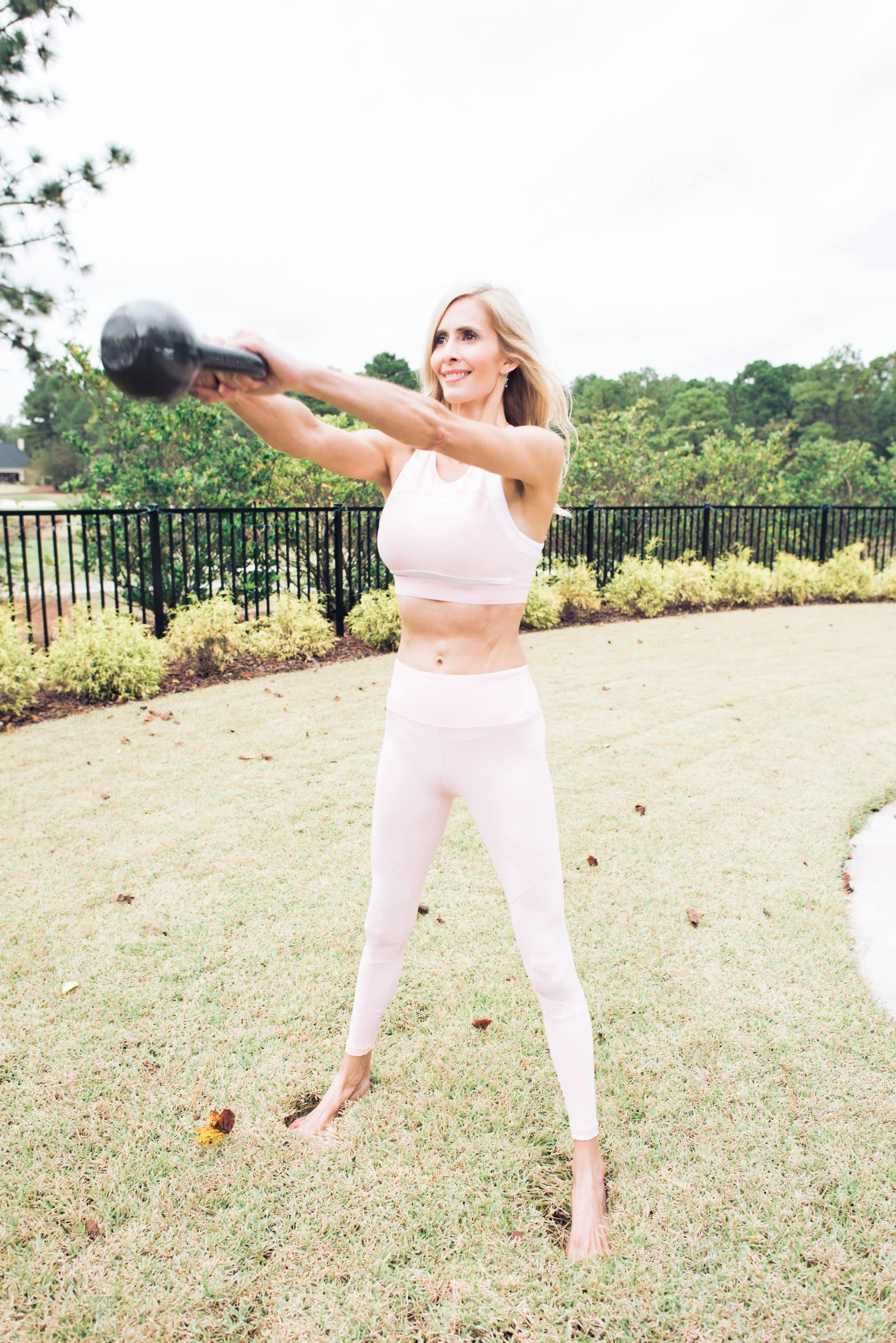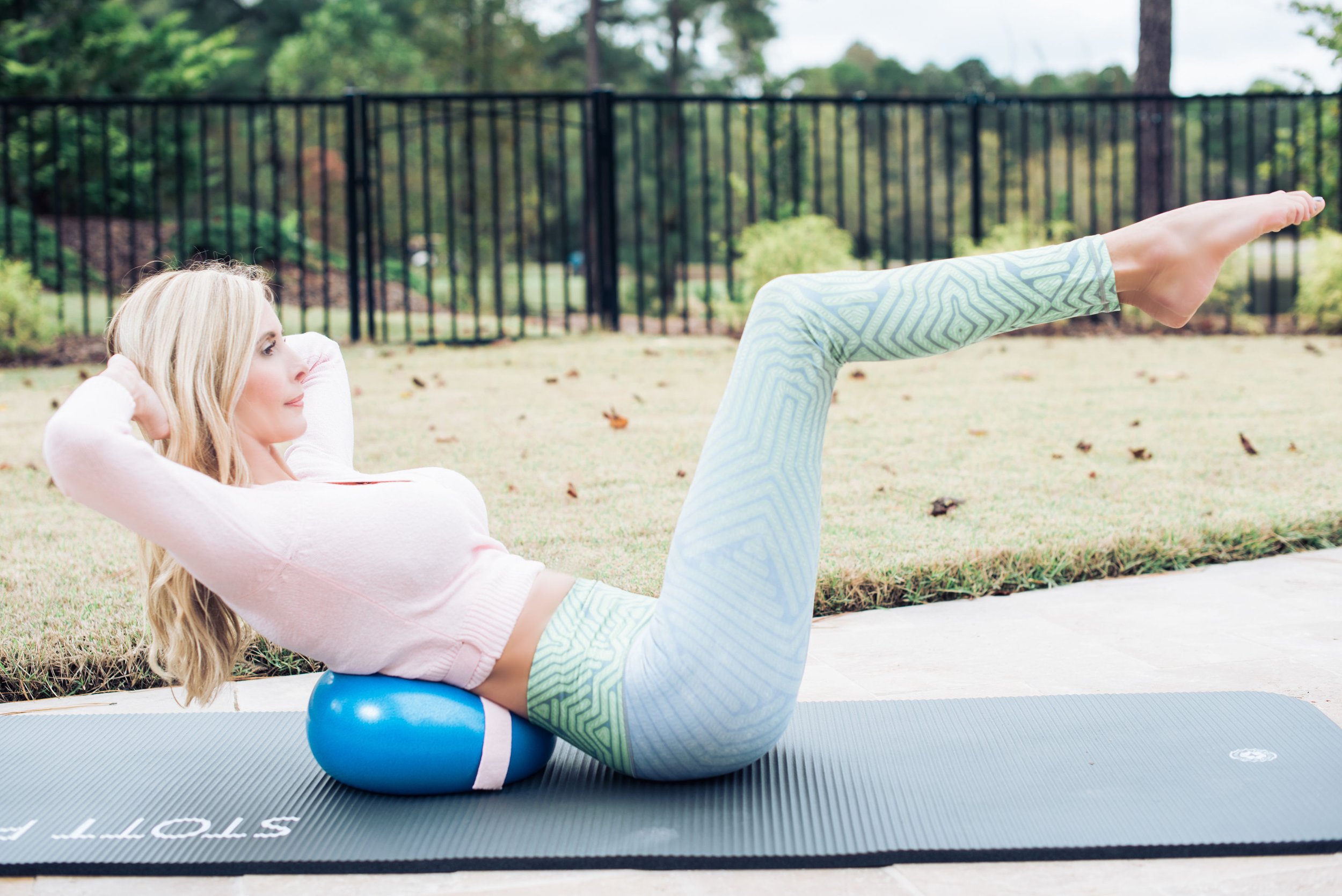Redefining Modern Menopause
My love of movement began at the tender age of two, when figure skates were laced up on my little Canadian feet. Skating consumed my whole childhood and adolescence. Early morning practices before school, after school and weekend practices, and entire summers spent shivering in a cold arena as my friends frolicked in the warm waters of the lake our town was settled on. But I loved it. We were fortunate to have world renowned instructors and learned that to excel in a sport, we had to cross train our bodies in many ways. My mom was a former figure skater and began lifting and bodybuilding in her 30’s. I would hop into my basket seat on her bike, and off we’d go to her little sweatbox of a gym that was full of big muscly men, and her! Training was a way of life that I became very accustomed to.
I earned my BScN in Canada, and moved after graduation to North Carolina, where I’ve been ever since. I practiced ER nursing for several years before finding Pilates. I had just had my first child, and my neck was constantly stiff and painful. I took my first Pilates lesson and was hooked immediately. My love of intelligent movement all came rushing back. It just made sense to my body and mind, and I knew I had to pursue a certification. After some time of practicing, I signed up for the STOTT comprehensive training while I was pregnant with my second child. And the rest is history. I have been teaching for 17 years, and I’m so thankful for that painful neck!
My 30’s were a very stressful time in my life. I was divorcing, and opening up my first commercial Pilates studio while navigating single motherhood and all that entails. I was the only instructor, and wearing far too many hats. I was traveling out of state regularly to certify Booty Barre instructors which was something I was so proud of and loved to do – but all of the stress started to take its toll. You would think since I was an RN, that I would have immediately acknowledged the signs of chronic stress, right? Wrong! As busy, overwhelmed women, we tend to stay hyper-focused on our goals, and what needs to be done for survival alone. Exhausted, pale and suddenly unable to recover from workouts? I’m just overwhelmed, I would tell myself. All women are. Dizzy, moody, disrupted sleep and losing muscle, strength and stamina? I’m stressed out, it’s to be expected! Chronically bloated, abdominal pain when I ate, a change in bowel habits and continued muscle loss despite eating well and working out? Developing strange fat deposits on my abdomen, having sudden panic attacks at night, breaking out into sweats and soaking my sheets? HOW many signs did my body have to give me?! We can be so busy, stressed and taking care of everyone and everything else, that our bodies can fall apart right in front of our own eyes, and we’ll still brush it off. I was living in survival mode, as so many of us do. I finally went to my primary care doctor, and thus began my journey into learning about chronic stress and perimenopause.
At 41, I still remember getting the call from the nurse - “looks like you’re in perimenopause. Have a good weekend!”. I stared down at my phone, flabbergasted. I didn’t think that would even be on my radar until my 50’s! No one told me what to expect. I wasn’t informed that I would have to change my eating, training and lifestyle in order for my perimenopausal body to continue to thrive. I was sent to different specialists for the myriad of symptoms I was experiencing - a gastroenterologist specialist for the small intestinal bacterial overgrowth (SIBO) I was diagnosed with; an endocrinologist to monitor my thyroid; a gynecologist to address getting started on HRT. I spent well over a year hop scotching from doctor to doctor, until I found an integrative physician who addressed me as a whole, and taught me about stress, cortisol and my HPA axis. She told me that no matter what prescription medications and supplements I took, it wouldn’t matter unless I addressed my stress management and cortisol levels. She was right. I decreased the frequency and intensity of my workouts and added in more long walks. I got more sleep. I ate more protein. I started lifting. I took more time to recover. I got out in the natural light upon waking and started to meditate. I learned how critical stress management was for perimenopausal women. We become so much more sensitive to stress when our estrogen and progesterone decrease and our cortisol levels elevate. The goal is not to throw more fuel on the fire by further increasing our cortisol. Sustained high cortisol, alongside the drop in estrogen, elevates blood sugar and insulin levels - leading to those changes in body composition we all dread.
I started wondering why I had seen SO many doctors, yet only one of them taught me about the physiology of perimenopause and chronic stress, and how to reverse many of the resultant symptoms. Through my research, I learned some pretty disturbing stats. By 2025, more than 1 billion women will be menopausal. Due to women living longer, the average woman can expect to spend 40% of her life in postmenopause - that’s not even taking into account the many years we can spend in perimenopause. According to the AARP, only 20% of obstetrician(ob)/gynecologist(gyn) residencies offer menopause training, and half of all US ob/gyn residents felt they needed more education on menopause medicine. 85% of perimenopausal and menopausal women experience symptoms that clinically impact quality of life. Who is going to competently care for all 1 billion of us?
As I started to post about my own experiences, more and more women were messaging me with their own harrowing stories of feeling invalidated and dismissed by their own doctors. They were angry, lost and losing hope of ever feeling like themselves again. I decided that I would spend the rest of my career working with women going through the menopause transition. We need education, guidance and support. I created MenoFit Method with the mission of putting women back in the driver’s seat of their menopausal journey. I teach women how to modify their nutrition, training and lifestyle to work with their changing physiology, so that they can maximize their fitness, health and wellness, and minimize their symptoms. This is achieved through menopause-friendly workouts, plenty of education and guidance, and community. This can be a very isolating and stressful time in a woman’s life - not only are we experiencing the mental and emotional effects of our shifting hormones, but we may also be dealing with aging parents, divorce and kids going to college. It can be complete overwhelm, and we need to be surrounded by like-minded women who understand and encourage one another. A strong sense of community is linked to improved mental and physical health.
It’s important for Pilates instructors to have a foundational understanding of the changes their menopausal clients are experiencing. For example, you can competently educate both current and prospective clients on why menopausal women need Pilates. The decline in estrogen leaves our menopausal clientele at risk for connective tissue and joint injuries. How many women have come to you with repetitive injuries from workouts like Cross Fit? They may not know that they are at much higher risk for injury due to peri/menopause. Pilates helps to develop strength, stability and mobility in a safe manner, and is a perfect way to start priming their bodies for the inclusion of lifting. The loss of muscle and bone density is accelerated during the menopause transition, leading to a higher risk of falls, fractures and a decrease in metabolism. Pilates helps to slow the muscle loss and stop the progression of osteoporosis. The mind-body aspect helps with mental processing, and their balance and coordination will also greatly benefit. The majority of menopausal women you train will be very concerned with changes in body composition and weight gain. Through understanding the physiology of peri/menopause, you can help steer them away from excessive steady state cardio and encourage them to do HIIT and SIT (sprint interval training) instead. You can emphasize the importance of safely incorporating heavier lifting alongside their Pilates practice, and giving their bodies extra recovery time when needed. You’ll know to direct them toward incorporating more non-exercise related movement throughout their day, because it accounts for 15% of caloric expenditure, vs working out at 5%. You can tell them how imperative it is for them to aim for eating 1g of protein per pound of bodyweight, and that this alone can significantly move the needle in the right direction.
Menopausal women want to feel seen, heard and understood. When they realize that you have taken the time to learn about the effects of menopause and can help to guide them in the right direction, you will have a loyal client for life. A little goes a long way. In addition to making them feel cared for, you will be able to instruct more competently. Take a few minutes before each session to ask them how they’re feeling. They may be experiencing hot flashes, major brain fog, erratic emotions, ringing ears, painful joints, headaches, and so much more. A gentler session, or specific modifications may be required.
Historically, menopause has been viewed as something to feel ashamed or embarrassed about. It has been associated with a loss of beauty and youth, weakness, hysteria, neurosis and even “living decay”. Women have been treated as though they are invisible and can no longer contribute to society. It’s time to bring menopause out from the shadows, and see it as a time to look forward, not back. Yes, it’s difficult. Yes, there will be many obstacles to overcome. But we have more wisdom now, than ever. We have science-backed education. We have amazing role models. I would argue that we’re better than ever! It’s time to celebrate this rite of passage and challenge ourselves to reach new heights and achieve new goals. Empowered by education, support and a positive mindset, we can feel and perform our best, and be free and powerful women. Let’s bring pilates and menopause together.
Michelle Laframboise is an RN, Pilates Instructor and creator of MenoFit Method. A passionate advocate for women's health, Michelle empowers women to reclaim their fitness, health and wellness throughout the menopause transition. She lives in North Carolina with her two kids and Rocco the Frenchie, who loves to steal the show in all of her Pilates videos!



